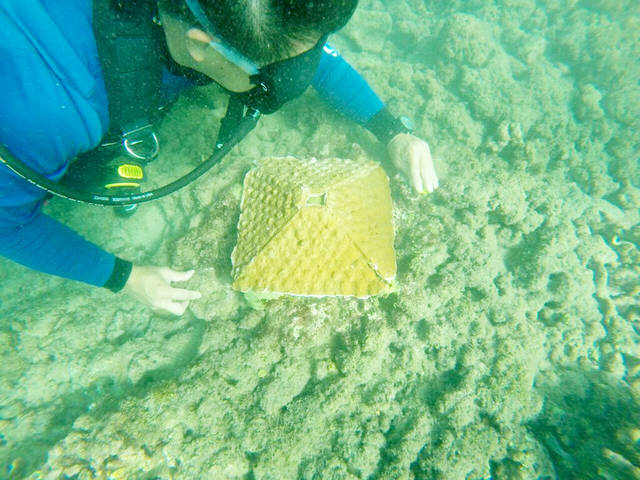In the filtered light streaming through the ocean at Sand Island, Hawaii’s newest garden is thriving on five pyramids attached to the substrate.
It’s the first out-planting of nursery-grown, Hawaii native corals from the ‘Anuenue Coral Restoration Nursery on Sand Island Access Road on Oahu, and the first step in a project meant to bolster coral reefs across the state.
The project began more than two years ago, according to the Hawaii Department of Land and Natural Resources Division of Aquatic Resources, in an endeavor to fast-grow what are typically slow-growing species of native Hawaiian coral.
“In some parts of the world, corals can grow 20 centimeters in a year. On Hawaii the rate is more like one centimeter per year,” said DAR coral ecologist David Gulko.
He continued: “(At the nursery, corals are) given the best food, the best lighting, the best water conditions and lots of tender loving care; all in an effort to grow them at a fast rate.”
Using 10-centimeter source fragments, nursery staff grow 42 centimeter pyramids of coral in eight to 10 months with their regimen of optimal light, food and conditions, and it is all thanks to a technique called microfracking.
That means taking a 10-centimeter coral fragment and splitting it into smaller, one-centimeter pieces that are arranged on the pyramid modules.
“Each of those pieces is genetically identical to each other and they grow together and form a colony again,” Gulko said. “They’re going to grow really fast because they can grow more directions at the same time than if they were all fused together.”
In both inside and outside tanks at the restoration nursery, small corals, mostly harvested from inside harbors are broken into very small pieces and then given the “5-Star treatment” Gulko says.
Once the corals have grown large enough on the pyramids, which DLNR says “resemble apple pies that rose high above their pans”, the coral pyramids are moved from the nursery’s gentle waters to the site offshore of Sand Island.
“We learned the pyramid modules withstand the high wave energy and less than pristine water conditions found in our near-shore reefs,” Gulko said.
The team from ‘Anuenue Coral Restoration Nursery has transported five pyramids to Sand Island State Park and, using a specially formulated epoxy that can be mixed in the water, they first clean an area, pat in the epoxy and affix the coral to the substrate.
The epoxy has been shown to not negatively impact corals, according to DLNR.
“We took the slow approach,” Gulko said, “because we wanted to work out all the bugs before starting to out-plant corals into natural reef environments. We haven’t lost any of the ones we out-planted.”
Sights are set on expansion for the project, though, and with the success of the Sand Island project and the goal is to double production to 220 large, 42-centimeter pyramid modules each year.
“Next year we’re shooting to grow an 80-centimeter coral in under a year,” Gulko said.
It generally takes 100 or 200 years to naturally grow a coral that size in Hawaii’s waters, he said.
As of now, Kauai is near the bottom of the list for project locations because of the sediment and chemicals that are flowing out onto the existing reefs.
“Sediment is really bad for coral and you’d need a facility on Kauai because it would be cost prohibitive to ship corals from Oahu to Kauai,” Gulko said. “There are some areas on Kauai (that have potential). Anini being one and Mana reef being another.”






